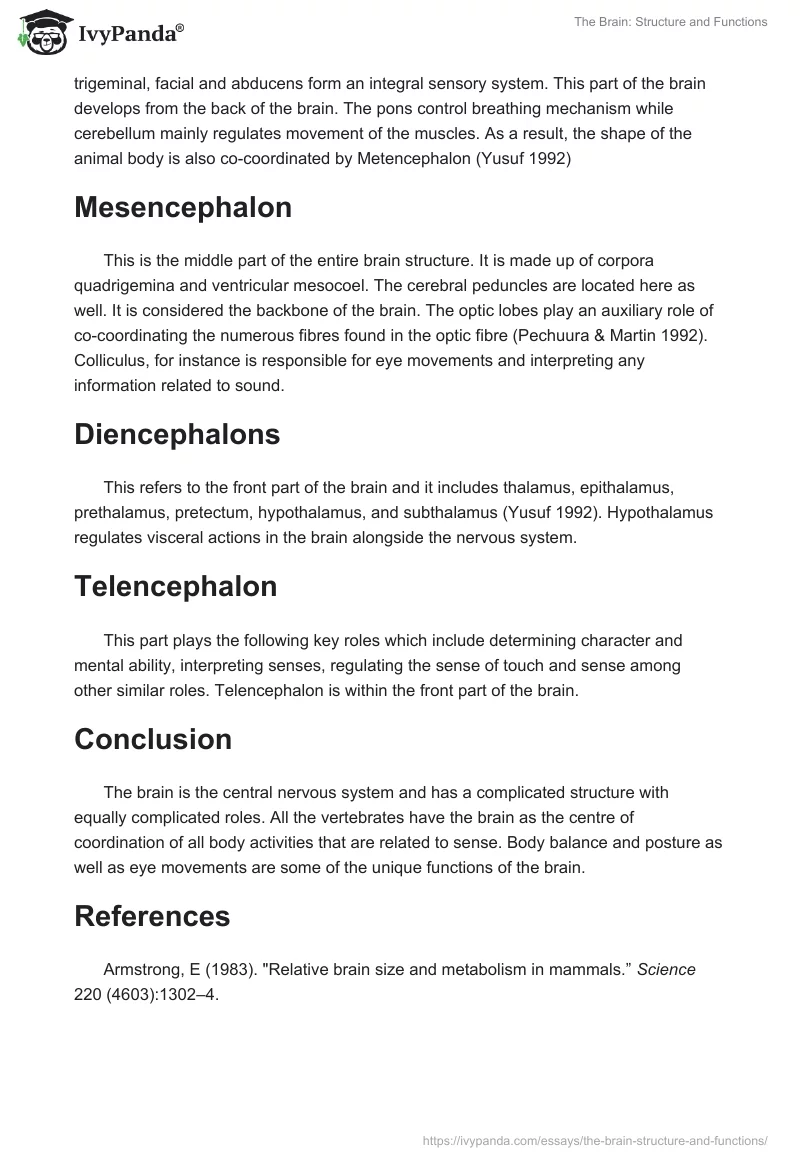Introduction
Brain constitutes the central nervous system among all the animals with backbones popularly known as the vertebrates. Also, most animals with no backbone have the brain system. Animals like starfish have nervous systems which are not central at all (Armstrong 1983). This substitutes the brain functions. Surprisingly, other small animals like the sponges do not have any nervous system whereas in vertebrates the position of the brain is right in the head. It is surrounded by the skull. The sensory organs of smell, balance, taste, and hearing are also located near the brain in vertebrates.
This paper is going to describe the major structures of the brain and the functions of each. The brain structures that are going to be of importance in this discussion include Myelencephalon, Metencephalon, Mesencephalon, Diencephalon and Telencephalon.
Myelencephalon
This is a very sensitive part of the brain system located in the central nervous system. Medulla oblongata is part of Myelencephalon. In this region, the fourth ventricle plays a key role. Some nerves called glossopharyngeal work alongside the other nerves as well. For example, Armstrong observes that the accessory, vagus and hypoglossal nerves all perform sensitive roles in Myelencephalon. They all work as a unit and none of them is independent in its functioning (1983). This brain part is different from Metencephalon because it is the one that eventually grows into medulla oblongata. When this brain part is about five weeks, it regulates very important body processes such as digestion, blood vessels, and heart working. According to Pechura and Martin (1991), Myelencephalon also plays the key role of controlling the back and forward movements commonly referred to as peristalsis.
Metencephalon
This part of the brain is composed of cerebellum and the pons. Some sections of the fourth ventricle are also found here. Critical nervous systems consisting of trigeminal, facial and abducens form an integral sensory system. This part of the brain develops from the back of the brain. The pons control breathing mechanism while cerebellum mainly regulates movement of the muscles. As a result, the shape of the animal body is also co-coordinated by Metencephalon (Yusuf 1992)
Mesencephalon
This is the middle part of the entire brain structure. It is made up of corpora quadrigemina and ventricular mesocoel. The cerebral peduncles are located here as well. It is considered the backbone of the brain. The optic lobes play an auxiliary role of co-coordinating the numerous fibres found in the optic fibre (Pechuura & Martin 1992). Colliculus, for instance is responsible for eye movements and interpreting any information related to sound.
Diencephalons
This refers to the front part of the brain and it includes thalamus, epithalamus, prethalamus, pretectum, hypothalamus, and subthalamus (Yusuf 1992). Hypothalamus regulates visceral actions in the brain alongside the nervous system.
Telencephalon
This part plays the following key roles which include determining character and mental ability, interpreting senses, regulating the sense of touch and sense among other similar roles. Telencephalon is within the front part of the brain.
Conclusion
The brain is the central nervous system and has a complicated structure with equally complicated roles. All the vertebrates have the brain as the centre of coordination of all body activities that are related to sense. Body balance and posture as well as eye movements are some of the unique functions of the brain.
References
Armstrong, E (1983). “Relative brain size and metabolism in mammals.” Science 220 (4603):1302–4.
Pechura M. C. and Martin J.B. (Eds.). (1991). Mapping the Brain and its Functions. Integrating Enabling Technologies into Neuroscience Research. National Academy Press, Washington D.C
Yusuf H.K.M (1992). Understanding the Brain and its Development. World Scientific Publishing Co. Pte. Ltd.


